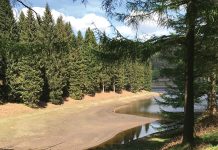Sludge Blanket detection is critical to the effective management of fundamental sludge processes and to achieving the significant downstream benefits that derive from proper sludge resource management. Automatic process balancing, control of penstock and bellmouth valves, cost savings through reduction of vehicle and personnel movements, together with issues around TOTEX and Compliance all depend heavily on accurate and reliable measurement of the strata of the sludge blanket. The developments within sludge blanket measurement technology over the last ten years means that we can now measure the sludge blanket and control and monitor the processes with every bit as much confidence as we measure open channel flow or pumping station operations, and using a very similar ultrasonic echo-processing technique.
Sludge Blanket detection and measurement is a challenge, as the borders of the various density strata blur into one another. The ‘traditional’ technique has been to manually dip a long tube, wielded by an operator perched on the clarifier bridge, who then uses his skill and experience to ‘judge’ the blanket level. That is usually followed by a long period of penstock adjustment to balance the process between the various tanks. In the majority of smaller sites, that’s the technique that is still in use. There are obvious immediate issues. The Health and Safety considerations of an operator having to physically lean over and dip the tank, in possibly icy and slippery conditions; the need for the operators then to spend significant time adjusting a process that can be handled automatically, the need to control in ‘coarse’ rather than ‘fine’ adjustments to ensure that Compliance is not breached by excess floc remaining in the final discharge, and so on. There are also some less obvious but still significant issues, such as the likelihood of tankering a great deal of excess water when the sludge is shipped to other sites for further processing, leading to extra tanker movements and so wasting time, fuel and money.
Over the years, there have been many attempts to automate the process. Notable among them have been mechanical systems of probes repeatedly lowered into the liquor, usually carrying an optical turbidity or infra-red sensor. A mechanical system carries obvious issues around fouling and maintenance, and these approaches have been notoriously difficult to set up and have often been unreliable and expensive.
Fundamentally, the challenge is to effectively measure the boundary between two material densities, in this case, between water and the very slightly higher density sludge. In another arena of water/wastewater measurement, one technique has, globally, become massively dominant: non-contacting ultrasonic measurement is in use in tens of thousands of applications in pumping stations and open channel flow measurement all over the world, measuring the relatively hard interface between air and water. Cost-effective, maintenance-free and reliable, the latest ultrasonic systems, such as Pulsar’s Ultimate Controller, now include sophisticated control processes and operate as pumping station controllers, with internet access, built-in RTU and even cameras to allow a clear view of the process. None of that sophistication would be possible without the basis of good, reliable, secure measurement to give operators and process owners the confidence to trust the equipment. At Pulsar, we have developed a bespoke echo processing system that we call DATEM. Refined over the twenty years that we have been in business, DATEM works by zeroing in on the correct echo, and then following it as the level moves up and down, using a sophisticated algorithm to ignore competing echoes, whether they come from chains, pump tops or stanchions. Anyone who has ever had to peer down a deep wet well will know just how cluttered and difficult an environment it can be.
In sludge blanket measurement, the challenge is slightly different, in that we are using a submerged transducer fixed to the bridge to discriminate between changes in densities that may only vary by as little as 0.5%. The process is the same though; in Pulsar’s Sludge Finder 2 system, for example, a Viper transducer produces a sound pulse that transmits throughout the clarifier process, reflecting throughout the interior of the clarifier to allow the Sludge Finder to build a detailed profile of the various densities within the liquor. It’s very much like the way a dolphin processes sonar signals to identify its prey and avoid obstructions. We can’t match the dolphin for detail and sophistication (yet!), but we are able to produce a clear profile of the varying densities within the process so that we can set limits that define the various boundary layers. Processing to the resolution required has only become possible with the latest industrial microprocessor speeds that allow the number of complex calculations per second to be performed. A good analogy might be the development of digital cameras, where clearer images through ever-increasing megapixel resolution have required the development of advanced sensors and the miniaturisation of more sophisticated processors.
A submerged transducer can still foul, of course, and the Viper transducer is fitted with a sweeping arm that keeps the face clear. A piezo-electric crystal provides the pulse that then reflects throughout the vessel, and is then re-energized by the returning signal, generating the data that is then analysed by the Sludge Finder 2 controller. Effective measurement is possible in all types of processes, including primary, secondary or tertiary clarifiers or SBR. In all cases a spectrum of densities is identified, which is then available for local or remote display and for either local control or signalling to a remote PLC/SCADA system.
There are many benefits to being able to produce a clear and continuously updated profile of the internal densities of the process, but we will look at two, beyond the main process control function of process balancing and identification of main blanket level: floc control and the opportunities for energy generation.
Floc level can be very difficult to monitor. Drifting ‘blooms’ of floc can billow around the process, passing close to the transducer face. Also, because it is so light, floc can creep up the process, overflow and pollute the watercourse even when the main blanket level is being well controlled. Floc level often becomes an issue in times of high flow or when the process has been disturbed. Pulsar have introduced a new feature in Sludge Finder 2, the High Floc alarm, which instructs Sludge Finder 2 to make a secondary assessment of the raw data being analysed, looking specifically for an increase of floc, which will bloom above the level of the main blanket, rising close to the top of the process.
By adding this additional layer of sophistication, it has become possible to completely automate the final treatment process. At Severn Trent’s site at Barnhurst, fourteen Sludge Finder 2 systems are relaying data back to a control cabin via radio telemetry links to adjust bellmouth valves, controlling the process to create a ‘healthy’ sludge level in the clarifiers. There have been two significant benefits. First, the number of callouts to the site have been greatly reduced because the Sludge Finder equipment is providing reliable and trustworthy measurement and control. That saves money and reduces vehicle movement by itself. The key benefit, though, is that this critical control point, final settlement and discharge, can now safely be trusted to an automated system. This installation uses a bellmouth valve, but the equipment can just as easily be applied to penstock or decant arm operations.
Moving on to the second point, green energy generation. There has been much investment in on-site turbine technology to generate power from the methane produced in the digesters, but to optimise their performance, and maximise the amount of gas produced, it is important to maximise the quality of the sludge delivered to them. At Stoke Bardolph in Nottingham, Pulsar’s Sludge Finder 2 systems are used to help to concentrate sludge from 2% to 6% before final processing in the on-site digesters. As a result, Stoke Bardolph is able to generate around 5.5MW (5500KW) at full power, making it not only self-sufficient in energy but also able to return green electricity to the national grid.
It is easy to forget, in many of these high-profile and capital intensive projects, that they would be difficult and in some cases impossible to achieve without the reliable and accurate instrumentation that lies at their heart. Sludge Blanket detection has become a key element of successful site management.





